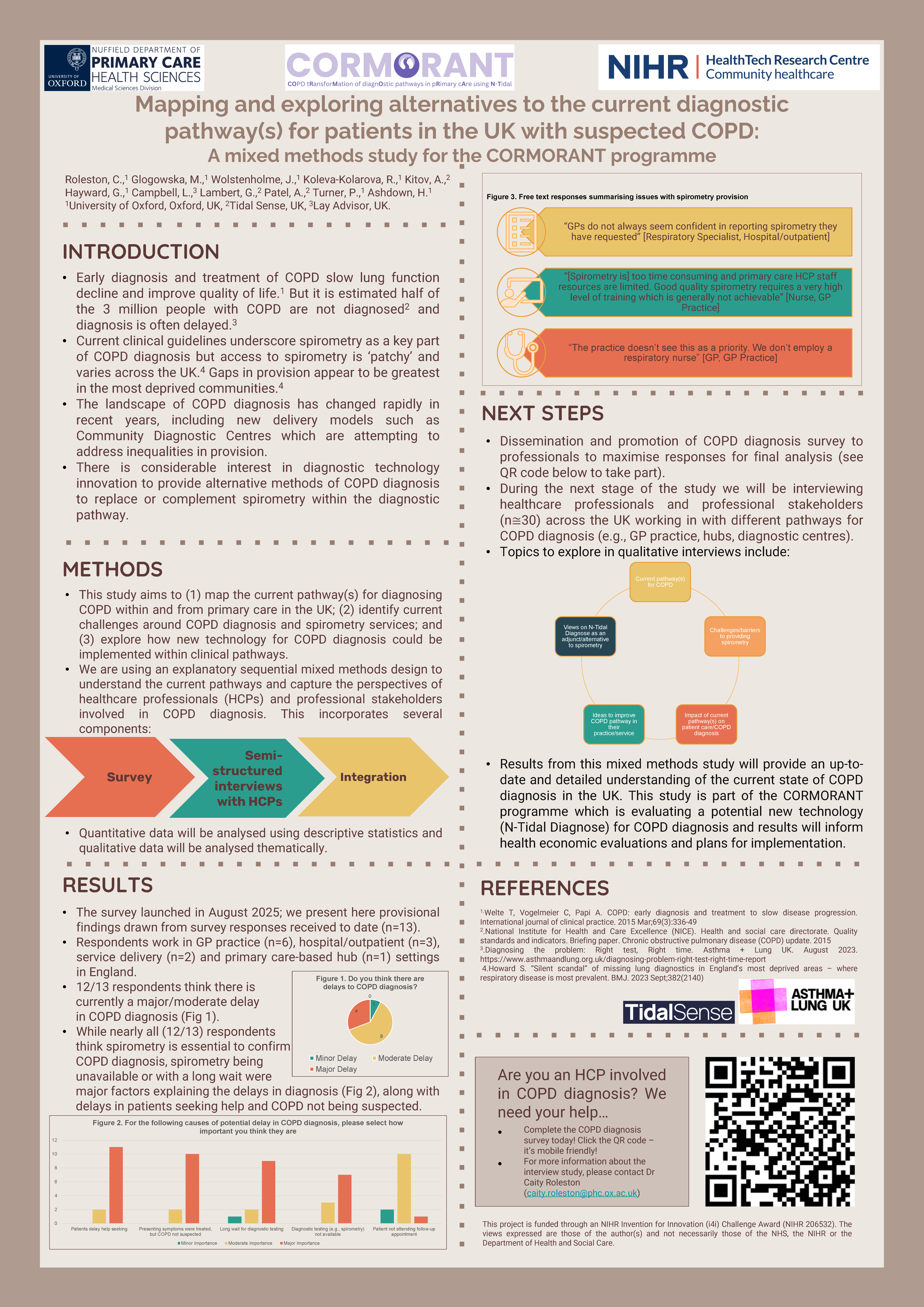Mapping and exploring alternatives to the current diagnostic pathway(s) for patients in the UK with suspected COPD: A mixed methods study for the CORMORANT programme (ID 662)
University of Oxford
Abstract
Introduction: Early diagnosis and treatment of COPD slow lung function decline and improve quality of life. But it is estimated half of the 3 million people with COPD are not diagnosed and diagnosis is often delayed. Current clinical guidelines underscore spirometry as a key part of COPD diagnosis but access to spirometry is ‘patchy’ and varies across UK. Gaps in provision appear to be greatest in the most deprived communities. The landscape of COPD diagnosis has changed rapidly in recent years, including new delivery models such as Community Diagnostic Centres which are attempting to address inequalities in provision. There is also considerable interest in diagnostic technology innovation to provide alternative methods of COPD diagnosis to replace or complement spirometry within the diagnostic pathway.
Aims/Objectives: 1) Conduct up-to-date mapping of UK diagnostic pathway(s) for patients with suspected COPD and understand what works and what doesn’t in care delivery. 2) Explore how new technology for COPD diagnosis could be implemented within clinical pathways.
Methods: This mixed methods study focuses on the perspectives of healthcare professionals and professional stakeholders (e.g., service delivery/planning roles) involved in COPD diagnosis. We developed an online questionnaire to capture the different ways COPD is diagnosed in adults in community/primary care, at Integrated Care Board and individual level. This will be followed by semi-structured interviews (n=20-30) with purposively selected informants to contextualise and supplement the quantitative evidence. Quantitative data will be analysed using descriptive statistics and qualitative data will be analysed thematically.
Results: Data collection and analysis are currently underway and will be presented ‘hot off the press’ at the conference.
Implications and Conclusion: This study is part of the CORMORANT programme which is evaluating a new technology which combines carbon dioxide waveform measurement with AI-derived software to determine the likelihood of COPD. Utilising mixed methods will afford both a breadth and depth of understanding of current diagnostic pathway(s) for COPD diagnosis. From this foundation we will be able to undertake health economic analysis and plan for implementation, aiming towards improvements for both patients and clinicians through a more comfortable and effective COPD diagnostic pathway.
Funding: This project is part of the CORMORANT (COPD tRansforMation of diagnostic pathways in pRimary cAre using N-Tidal) programme. It is funded through an NIHR Invention for Innovation (i4i) Challenge award (NIHR 206532) which provides funding for collaborative research between industry and academia to further health technology development. The programme is co-led by the company TidalSense (who are the NIHR grant holders) and the University of Oxford. The team from the University of Oxford is undertaking the research under a collaboration agreement with TidalSense. TidalSense have inputted into the study design to ensure that it meets the planned outcomes of the programme bringing in their knowledge of the technology and the existing landscape, but they will have no role in the collection of data or its analysis. University of Oxford co-authors have no financial interest in TidalSense. The views expressed are those of the author(s) and not necessarily those of the NHS, the NIHR or the Department of Health and Social Care.
Conflicts of interest: Ameera Patel - Is a shareholder of TidalSense Limited.
Helen Ashdown - Declares payment to the University of Oxford for project collaboration and speaker fees from Boehringer Ingelheim Ltd.
Gail Hayward - Has helped lead studies which have received either diagnostic materials or funding from Roche, LumiraDx, and BD, and is part of the IMI-funded Value Dx project.
